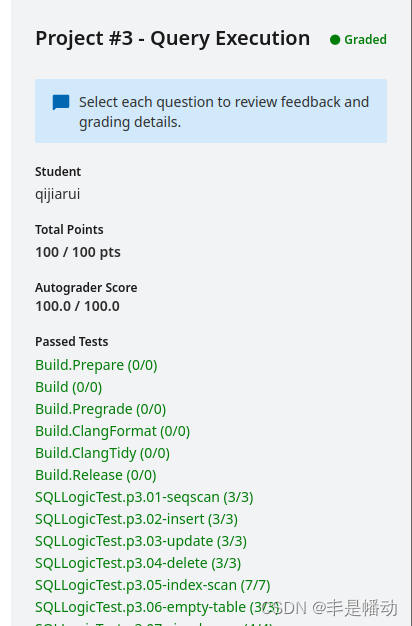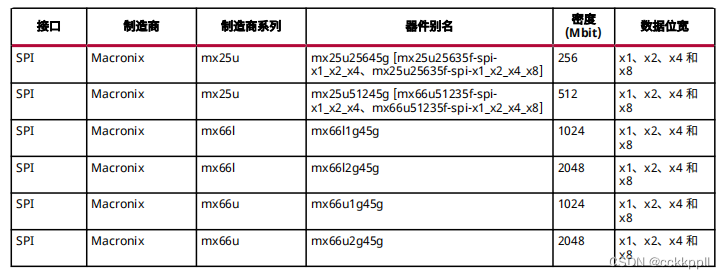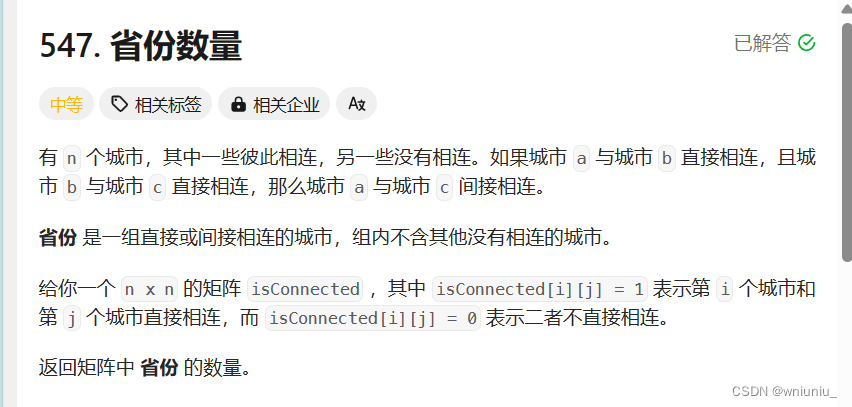QUERY EXECUTION task3/task4
- Task #3 - HashJoin Executor and Optimization
- 1、HashJoin
- 1.1 思路
- 1.2 代码
- 2 NestedLoopJoin优化为HashJoin
- 2.1 思路
- 2.2 代码
- Task #4 Sort + Limit Executors + Top-N Optimization+ Window Functions
- 1、Sort
- 1.1 思路
- 1.2 代码
- 2、Limit Executors
- 2.1 思路
- 2.2 代码
- 3、Top-N Optimization
- 3.1 思路
- 3.2 代码
- 3.3 优化
- 4、Window Functions
- 4.1 思路
- 4.2 代码
Task #3 - HashJoin Executor and Optimization
1、HashJoin
1.1 思路
哈希连接包括两个阶段:构建(build)阶段和探测(probe)阶段。
构建阶段:遍历右表,将每个元组的连接键哈希并存储在哈希表中。
探测阶段:遍历左表,对表中的每个元组进行哈希,并在哈希表中查找具有相同哈希值的条目。由于右表可能有好几个和左表匹配的选项,所以还需要一个迭代器
其中需要注意,如果是左连接,没找到对应哈希值要把左边对应的右边写null。如果是内连接,跳过下一个。
1.2 代码
#include "execution/executors/hash_join_executor.h"
namespace bustub {
HashJoinExecutor::HashJoinExecutor(ExecutorContext *exec_ctx, const HashJoinPlanNode *plan,
std::unique_ptr<AbstractExecutor> &&left_child,
std::unique_ptr<AbstractExecutor> &&right_child)
: AbstractExecutor(exec_ctx) {
this->plan_ = plan;
this->left_child_ = std::move(left_child);
this->right_child_ = std::move(right_child);
if (!(plan->GetJoinType() == JoinType::LEFT || plan->GetJoinType() == JoinType::INNER)) {
// Note for 2023 Fall: You ONLY need to implement left join and inner join.
throw bustub::NotImplementedException(fmt::format("join type {} not supported", plan->GetJoinType()));
}
}
void HashJoinExecutor::Init() {
// 初始化左右plan的左右孩子
this->left_child_->Init();
this->right_child_->Init();
// 获取左执行器符合条件的元组,left_bool_用于判断左执行器是否还有符合条件的元组
left_bool_ = left_child_->Next(&left_tuple_, &left_rid_);
// NEXT方法的輸出參數,用于存储查询结果
Tuple right_tuple{};
RID right_rid{};
//构建哈希表
jht_ = std::make_unique<SimpleHashJoinHashTable>();
// 遍历子执行器,将右子执行器中的获取的数据插入到join哈希表中
// 不能在HashJoinExecutor执行器的next中完成,因为执行器需要先从子执行器中获取所有数据,然后对这些数据进行join,最后才能产生输出结果
while (right_child_->Next(&right_tuple, &right_rid)) {
jht_->InsertKey(GetRightJoinKey(&right_tuple), right_tuple);
}
// 获取左侧元组的hash key
auto left_hash_key = GetLeftJoinKey(&left_tuple_);
// 在哈希表中查找与左侧元组匹配的右侧元组
right_tuple_ = jht_->GetValue(left_hash_key);
//这里必须判断right_tuple_是否为空,否则指针会指向空地址报错
// 不为空说明找到了哈希值一样的
if (right_tuple_ != nullptr) {
jht_iterator_ = right_tuple_->begin();
// 标记为true,防止next函数中重复输出
has_done_ = true;
} else {
// 标记为false,主要用于左连接没有匹配的情况
has_done_ = false;
}
}
auto HashJoinExecutor::Next(Tuple *tuple, RID *rid) -> bool {
// 用while的原因:如果是内连接,如果没有匹配的元组,则该轮不输出任何元组,不需要返回值,继续往下查找其他左元组
while (true) {
// 如果right_tuple_不为空,且jht_iterator_未遍历完,则遍历输出
// 一个左边可能匹配多个右边
if (right_tuple_ != nullptr && jht_iterator_ != right_tuple_->end()) {
std::vector<Value> values;
auto right_tuple = *jht_iterator_;
for (uint32_t i = 0; i < this->left_child_->GetOutputSchema().GetColumnCount(); i++) {
values.emplace_back(left_tuple_.GetValue(&this->left_child_->GetOutputSchema(), i));
}
// 连接操作右边元组的值均不为null
for (uint32_t i = 0; i < this->right_child_->GetOutputSchema().GetColumnCount(); i++) {
values.emplace_back(right_tuple.GetValue(&this->right_child_->GetOutputSchema(), i));
}
*tuple = Tuple{values, &GetOutputSchema()};
++jht_iterator_;
return true;
}
// 如果right_tuple_为空,或者jht_iterator_遍历完,且为左连接
// 如果has_done_为false,则说明左连接没有匹配的元组,需要输出右元组为null的情况
if (plan_->GetJoinType() == JoinType::LEFT && !has_done_) {
std::vector<Value> values;
for (uint32_t i = 0; i < this->left_child_->GetOutputSchema().GetColumnCount(); i++) {
values.emplace_back(left_tuple_.GetValue(&this->left_child_->GetOutputSchema(), i));
}
// 连接操作右边元组的值均不为null
for (uint32_t i = 0; i < this->right_child_->GetOutputSchema().GetColumnCount(); i++) {
values.emplace_back(
ValueFactory::GetNullValueByType(this->right_child_->GetOutputSchema().GetColumn(i).GetType()));
}
*tuple = Tuple{values, &GetOutputSchema()};
has_done_ = true;
return true;
}
// 如果不是左连接,或者为左连接,但有有效输出,则继续遍历下一个左元组进行匹配
// 如果left_bool_为false,左边找完了
left_bool_ = left_child_->Next(&this->left_tuple_, &this->left_rid_);
if (!left_bool_) {
return false;
}
// 重置右边匹配的元组,以及更新迭代器
auto left_hash_key = GetLeftJoinKey(&left_tuple_);
// 在哈希表中查找与左侧元组匹配的右侧元组
right_tuple_ = jht_->GetValue(left_hash_key);
if (right_tuple_ != nullptr) {
jht_iterator_ = right_tuple_->begin();
has_done_ = true;
} else {
has_done_ = false;
}
}
}
} // namespace bustub
#include <memory>
#include <utility>
#include "aggregation_executor.h"
#include "execution/executor_context.h"
#include "execution/executors/abstract_executor.h"
#include "execution/plans/hash_join_plan.h"
#include "storage/table/tuple.h"
namespace bustub {
/** HashJoinKeyrepresents a key in an join operation */
struct HashJoinKey {
std::vector<Value> hash_keys_;
/**
* Compares two hash joi keys for equality
* @param other the other hash join key to be compared with
* @return `true` if both hash join key have equivalent values
*/
auto operator==(const HashJoinKey &other) const -> bool {
// 比较两个对象的hash_keys_成员中的每个Value对象是否相等
for (uint32_t i = 0; i < other.hash_keys_.size(); ++i) {
if (hash_keys_[i].CompareEquals(other.hash_keys_[i]) != CmpBool::CmpTrue) {
return false;
}
}
return true;
}
};
} // namespace bustub
namespace std {
/** Implements std::hash on AggregateKey */
template <>
struct hash<bustub::HashJoinKey> {
auto operator()(const bustub::HashJoinKey &join_key) const -> std::size_t {
size_t curr_hash = 0;
for (const auto &key : join_key.hash_keys_) {
if (!key.IsNull()) {
// 对每一个非空的value对象,计算出它的哈希值
curr_hash = bustub::HashUtil::CombineHashes(curr_hash, bustub::HashUtil::HashValue(&key));
}
}
return curr_hash;
}
};
} // namespace std
namespace bustub {
/**
* A simplified hash table that has all the necessary functionality for join.
*/
class SimpleHashJoinHashTable {
public:
/** 插入join key和tuple构建hash表 */
void InsertKey(const HashJoinKey &join_key, const Tuple &tuple) {
if (ht_.count(join_key) == 0) {
std::vector<Tuple> tuple_vector;
tuple_vector.push_back(tuple);
ht_.insert({join_key, tuple_vector});
} else {
ht_.at(join_key).push_back(tuple);
}
}
/** 获取该join key对应的tuple */
auto GetValue(const HashJoinKey &join_key) -> std::vector<Tuple> * {
if (ht_.find(join_key) == ht_.end()) {
return nullptr;
}
return &(ht_.find(join_key)->second);
}
/**
* Clear the hash table
*/
void Clear() { ht_.clear(); }
private:
/** The hash table is just a map from aggregate keys to aggregate values */
std::unordered_map<HashJoinKey, std::vector<Tuple>> ht_{};
};
/**
* HashJoinExecutor executes a nested-loop JOIN on two tables.
*/
class HashJoinExecutor : public AbstractExecutor {
public:
/**
* Construct a new HashJoinExecutor instance.
* @param exec_ctx The executor context
* @param plan The HashJoin join plan to be executed
* @param left_child The child executor that produces tuples for the left side of join
* @param right_child The child executor that produces tuples for the right side of join
*/
HashJoinExecutor(ExecutorContext *exec_ctx, const HashJoinPlanNode *plan,
std::unique_ptr<AbstractExecutor> &&left_child, std::unique_ptr<AbstractExecutor> &&right_child);
/** Initialize the join */
void Init() override;
/**
* Yield the next tuple from the join.
* @param[out] tuple The next tuple produced by the join.
* @param[out] rid The next tuple RID, not used by hash join.
* @return `true` if a tuple was produced, `false` if there are no more tuples.
*/
auto Next(Tuple *tuple, RID *rid) -> bool override;
/** @return The output schema for the join */
auto GetOutputSchema() const -> const Schema & override { return plan_->OutputSchema(); };
private:
auto GetLeftJoinKey(const Tuple *tuple) -> HashJoinKey {
std::vector<Value> values;
for (const auto &expr : plan_->LeftJoinKeyExpressions()) {
values.emplace_back(expr->Evaluate(tuple, left_child_->GetOutputSchema()));
}
return {values};
}
auto GetRightJoinKey(const Tuple *tuple) -> HashJoinKey {
std::vector<Value> values;
for (const auto &expr : plan_->RightJoinKeyExpressions()) {
values.emplace_back(expr->Evaluate(tuple, right_child_->GetOutputSchema()));
}
return {values};
}
/** The HashJoin plan node to be executed. */
const HashJoinPlanNode *plan_;
// 遍历哈希表的迭代器
std::vector<Tuple>::iterator jht_iterator_;
// 哈希表
std::unique_ptr<SimpleHashJoinHashTable> jht_;
// 指向左表的执行器对象
std::unique_ptr<AbstractExecutor> left_child_;
// 指向右表的执行器对象
std::unique_ptr<AbstractExecutor> right_child_;
Tuple left_tuple_{};
RID left_rid_{};
std::vector<Tuple> *right_tuple_{nullptr};
bool has_done_;
// 用来判断左边还有没有符合要求的元组
bool left_bool_;
};
} // namespace bustub
2 NestedLoopJoin优化为HashJoin
2.1 思路
查询计划是从下往上的树形结构,所以要现在做下面再搞上面(用递归实现)
注意:要检查每个等值条件两侧的列属于哪个表。
步骤:
1、把子节点用递归的方式添加到 optimized_children 列表中
2、用 CloneWithChildren 方法克隆原始计划,并用优化后的子节点替换原始的子节点。这样即使实际没优化成,也说明尝试优化过了
3、看优化为hashjoin的条件满不满足
4、满足则换,不满足输出原计划
2.2 代码
#include <algorithm>
#include <memory>
#include "execution/expressions/column_value_expression.h"
#include "execution/expressions/comparison_expression.h"
#include "execution/expressions/logic_expression.h"
#include "execution/plans/abstract_plan.h"
#include "execution/plans/hash_join_plan.h"
#include "execution/plans/nested_loop_join_plan.h"
#include "optimizer/optimizer.h"
namespace bustub {
// 解析一个逻辑表达式,并提取出左右两侧的关键表达式
void ParseAndExpression(const AbstractExpressionRef &predicate,
std::vector<AbstractExpressionRef> *left_key_expressions,
std::vector<AbstractExpressionRef> *right_key_expressions) {
// 尝试将谓词转换为逻辑表达式,与或非
auto *logic_expression_ptr = dynamic_cast<LogicExpression *>(predicate.get());
// 递归处理逻辑逻辑表达式
if (logic_expression_ptr != nullptr) {
// left child
ParseAndExpression(logic_expression_ptr->GetChildAt(0), left_key_expressions, right_key_expressions);
// right child
ParseAndExpression(logic_expression_ptr->GetChildAt(1), left_key_expressions, right_key_expressions);
}
// 尝试将谓词转换为比较表达式
auto *comparison_ptr = dynamic_cast<ComparisonExpression *>(predicate.get());
// 如果是比较表达式
if (comparison_ptr != nullptr) {
auto column_value_1 = dynamic_cast<const ColumnValueExpression &>(*comparison_ptr->GetChildAt(0));
// auto column_value_2 = dynamic_cast<const ColumnValueExpression &>(*comparison_ptr->GetChildAt(1));
// 区分每个数据元素是从左侧表还是右侧表提取的,例如 A.id = B.id时,系统需要知道 A.id 和 B.id 分别属于哪个数据源
if (column_value_1.GetTupleIdx() == 0) {
left_key_expressions->emplace_back(comparison_ptr->GetChildAt(0));
right_key_expressions->emplace_back(comparison_ptr->GetChildAt(1));
} else {
left_key_expressions->emplace_back(comparison_ptr->GetChildAt(1));
right_key_expressions->emplace_back(comparison_ptr->GetChildAt(0));
}
}
}
auto Optimizer::OptimizeNLJAsHashJoin(const AbstractPlanNodeRef &plan) -> AbstractPlanNodeRef {
// TODO(student): implement NestedLoopJoin -> HashJoin optimizer rule
// Note for 2023 Fall: You should support join keys of any number of conjunction of equi-condistions:
// E.g. <column expr> = <column expr> AND <column expr> = <column expr> AND ...
std::vector<AbstractPlanNodeRef> optimized_children;
for (const auto &child : plan->GetChildren()) {
// 递归调用
optimized_children.emplace_back(OptimizeNLJAsHashJoin(child));
}
auto optimized_plan = plan->CloneWithChildren(std::move(optimized_children));
if (optimized_plan->GetType() == PlanType::NestedLoopJoin) {
const auto &join_plan = dynamic_cast<const NestedLoopJoinPlanNode &>(*optimized_plan);
// 获取谓词
auto predicate = join_plan.Predicate();
std::vector<AbstractExpressionRef> left_key_expressions;
std::vector<AbstractExpressionRef> right_key_expressions;
// 提取左右两侧关键表达式,分别放到left_key_expressions和right_key_expressions里)
ParseAndExpression(predicate, &left_key_expressions, &right_key_expressions);
return std::make_shared<HashJoinPlanNode>(join_plan.output_schema_, join_plan.GetLeftPlan(),
join_plan.GetRightPlan(), left_key_expressions, right_key_expressions,
join_plan.GetJoinType());
}
return optimized_plan;
}
} // namespace bustub
这个完成后可以运行SQLLogicTests - #14 和#15.
Task #4 Sort + Limit Executors + Top-N Optimization+ Window Functions
这个感觉比前面的都简单
1、Sort
1.1 思路
要求:默认升序
Init函数把元组顺序排好。Next函数从开始位置一个个输出
1.2 代码
#include <memory>
#include <vector>
#include "execution/executor_context.h"
#include "execution/executors/abstract_executor.h"
#include "execution/plans/seq_scan_plan.h"
#include "execution/plans/sort_plan.h"
#include "storage/table/tuple.h"
namespace bustub {
// 用于排序的比较器
class Comparator {
public:
Comparator() { schema_ = nullptr; }
Comparator(const Schema *schema, std::vector<std::pair<OrderByType, AbstractExpressionRef>> order_bys)
: schema_(schema), order_bys_(std::move(order_bys)) {}
auto operator()(const Tuple &t1, const Tuple &t2) -> bool {
for (auto const &order_by : this->order_bys_) {
const auto order_type = order_by.first;
// 使用Evaluate获取值
AbstractExpressionRef expr = order_by.second;
Value v1 = expr->Evaluate(&t1, *schema_);
Value v2 = expr->Evaluate(&t2, *schema_);
if (v1.CompareEquals(v2) == CmpBool::CmpTrue) {
continue;
}
// 如果是升序(ASC 或 DEFAULT),比较 v1 是否小于 v2(CompareLessThan)
if (order_type == OrderByType::ASC || order_type == OrderByType::DEFAULT) {
return v1.CompareLessThan(v2) == CmpBool::CmpTrue;
}
// 如果是降序(DESC),比较 v1 是否大于 v2(CompareGreaterThan)
return v1.CompareGreaterThan(v2) == CmpBool::CmpTrue;
}
// 两个元组所有键都相等
return false;
}
private:
const Schema *schema_;
// 两个参数:升序还是降序,用那个键的值
std::vector<std::pair<OrderByType, AbstractExpressionRef>> order_bys_;
};
/**
* The SortExecutor executor executes a sort.
*/
class SortExecutor : public AbstractExecutor {
public:
/**
* Construct a new SortExecutor instance.
* @param exec_ctx The executor context
* @param plan The sort plan to be executed
*/
SortExecutor(ExecutorContext *exec_ctx, const SortPlanNode *plan, std::unique_ptr<AbstractExecutor> &&child_executor);
/** Initialize the sort */
void Init() override;
/**
* Yield the next tuple from the sort.
* @param[out] tuple The next tuple produced by the sort
* @param[out] rid The next tuple RID produced by the sort
* @return `true` if a tuple was produced, `false` if there are no more tuples
*/
auto Next(Tuple *tuple, RID *rid) -> bool override;
/** @return The output schema for the sort */
auto GetOutputSchema() const -> const Schema & override { return plan_->OutputSchema(); }
private:
/** The sort plan node to be executed */
const SortPlanNode *plan_;
// 生成要排序的数据
std::unique_ptr<AbstractExecutor> child_executor_;
std::vector<Tuple> tuples_;
std::vector<Tuple>::iterator iter_;
};
} // namespace bustub
SortExecutor::SortExecutor(ExecutorContext *exec_ctx, const SortPlanNode *plan,
std::unique_ptr<AbstractExecutor> &&child_executor)
: AbstractExecutor(exec_ctx) {
this->plan_ = plan;
this->child_executor_ = std::move(child_executor);
}
void SortExecutor::Init() {
child_executor_->Init();
Tuple tuple{};
RID rid{};
while (child_executor_->Next(&tuple, &rid)) {
tuples_.emplace_back(tuple);
}
// 获取排序字段
auto order_by = plan_->GetOrderBy();
// 排序
std::sort(tuples_.begin(), tuples_.end(), Comparator(&this->GetOutputSchema(), order_by));
iter_ = tuples_.begin();
}
auto SortExecutor::Next(Tuple *tuple, RID *rid) -> bool {
// 调用的时候返回,从头到尾一个个返回
if (iter_ != tuples_.end()) {
*tuple = *iter_;
++iter_;
return true;
}
return false;
}
2、Limit Executors
2.1 思路
要求: 限制元组(记录或行)的数量。没什么说的。
2.2 代码
LimitExecutor::LimitExecutor(ExecutorContext *exec_ctx, const LimitPlanNode *plan,
std::unique_ptr<AbstractExecutor> &&child_executor)
: AbstractExecutor(exec_ctx) {
this->plan_ = plan;
this->child_executor_ = std::move(child_executor);
}
void LimitExecutor::Init() {
child_executor_->Init();
std::size_t count = 0;
auto limit = plan_->GetLimit();
Tuple tuple{};
RID rid{};
// 获取符合条件数量的元组
while (count < limit && child_executor_->Next(&tuple, &rid)) {
count++;
tuples_.emplace_back(tuple);
}
if (!tuples_.empty()) {
iter_ = tuples_.begin();
}
}
auto LimitExecutor::Next(Tuple *tuple, RID *rid) -> bool {
if (!tuples_.empty() && iter_ != tuples_.end()) {
*tuple = *iter_;
iter_++;
return true;
}
return false;
}
private:
/** The limit plan node to be executed */
const LimitPlanNode *plan_;
/** The child executor from which tuples are obtained */
std::unique_ptr<AbstractExecutor> child_executor_;
std::vector<Tuple> tuples_;
std::vector<Tuple>::iterator iter_;
3、Top-N Optimization
3.1 思路
比较器的实现和sort里的Comparator是一样的。
Init函数里用
std::priority_queue<Tuple, std::vector<Tuple>, HeapComparator> heap(
HeapComparator(&this->GetOutputSchema(), plan_->GetOrderBy()));
定义一个可以排序的(HeapComparator实现)、存储top-n元组的堆
3.2 代码
TopNExecutor::TopNExecutor(ExecutorContext *exec_ctx, const TopNPlanNode *plan,
std::unique_ptr<AbstractExecutor> &&child_executor)
: AbstractExecutor(exec_ctx) {
this->plan_ = plan;
this->child_executor_ = std::move(child_executor);
}
void TopNExecutor::Init() {
child_executor_->Init();
//使用优先队列存储topN,升序用大顶堆,降序用小顶堆
std::priority_queue<Tuple, std::vector<Tuple>, HeapComparator> heap(
HeapComparator(&this->GetOutputSchema(), plan_->GetOrderBy()));
Tuple tuple{};
RID rid{};
//遍历子执行器,将子执行器返回的元组加入优先队列
while (child_executor_->Next(&tuple, &rid)) {
heap.push(tuple);
heap_size_++;
//因為只需要topN个元组,所以当优先队列大小大于topN时,弹出堆顶元组(如果是升序,堆顶是最大的元组,如果是降序,堆顶是最小的元组)
if (heap.size() > plan_->GetN()) {
heap.pop();
heap_size_--;
}
}
while (!heap.empty()) {
this->top_entries_.push(heap.top());
heap.pop();
}
}
auto TopNExecutor::Next(Tuple *tuple, RID *rid) -> bool {
if (top_entries_.empty()) {
return false;
}
*tuple = top_entries_.top();
top_entries_.pop();
return true;
}
private:
/** The TopN plan node to be executed */
const TopNPlanNode *plan_;
/** The child executor from which tuples are obtained */
std::unique_ptr<AbstractExecutor> child_executor_;
// 按順序存储优先队列中的tuple
/** The stack to store sorted top-n tuple*/
std::stack<Tuple> top_entries_;
size_t heap_size_{0};
3.3 优化
要求: 将带有 ORDER BY + LIMIT 子句的查询转换为使用 TopNExecutor
优化的实现和前面优化成hashjoin的有点像
步骤:
1、把子节点用递归的方式添加到 optimized_children 列表中
2、用 CloneWithChildren 方法克隆原始计划,并用优化后的子节点替换原始的子节点。这样即使实际没优化成,也说明尝试优化过了
3、看优化为Top-N的条件满不满足,即有没有limit+orderby
4、满足就换,不满足输出原计划
#include "execution/plans/limit_plan.h"
#include "execution/plans/sort_plan.h"
#include "execution/plans/topn_plan.h"
#include "optimizer/optimizer.h"
namespace bustub {
auto Optimizer::OptimizeSortLimitAsTopN(const AbstractPlanNodeRef &plan) -> AbstractPlanNodeRef {
// TODO(student): implement sort + limit -> top N optimizer rule
// 对所有子节点递归应用这一优化
std::vector<bustub::AbstractPlanNodeRef> optimized_children;
for (const auto &child : plan->GetChildren()) {
optimized_children.emplace_back(OptimizeSortLimitAsTopN(child));
}
auto optimized_plan = plan->CloneWithChildren(std::move(optimized_children));
if (optimized_plan->GetType() == PlanType::Limit) {
const auto &limit_plan = dynamic_cast<const LimitPlanNode &>(*optimized_plan);
auto child = optimized_plan->children_[0];
if (child->GetType() == PlanType::Sort) {
const auto &sort_plan = dynamic_cast<const SortPlanNode &>(*child);
return std::make_shared<TopNPlanNode>(optimized_plan->output_schema_, optimized_plan->children_[0],
sort_plan.GetOrderBy(), limit_plan.limit_);
}
}
return optimized_plan;
}
} // namespace bustub
4、Window Functions
4.1 思路
看下官方介绍:https://15445.courses.cs.cmu.edu/fall2023/project3/#optimizer-guide,很详细了
不想写了,我要出去玩。要是有人看,帮我写了我粘上去吧
4.2 代码
#include "execution/executors/window_function_executor.h"
#include "execution/executors/aggregation_executor.h"
#include "execution/executors/sort_executor.h"
#include "execution/plans/window_plan.h"
#include "storage/table/tuple.h"
namespace bustub {
WindowFunctionExecutor::WindowFunctionExecutor(ExecutorContext *exec_ctx, const WindowFunctionPlanNode *plan,
std::unique_ptr<AbstractExecutor> &&child_executor)
: AbstractExecutor(exec_ctx), plan_(plan), child_executor_(std::move(child_executor)) {}
void WindowFunctionExecutor::Init() {
child_executor_->Init();
// 获取窗口函数的信息
auto window_functions = plan_->window_functions_;
// 获取列数
auto cloumn_size = plan_->columns_.size();
//创建各类vection用于存储窗口函数的具体信息
// 是否需要排序
std::vector<bool> is_order_by(plan_->columns_.size());
// 窗口函数表达式
std::vector<AbstractExpressionRef> window_exprs(cloumn_size);
// 窗口函数类型
std::vector<WindowFunctionType> window_function_types(cloumn_size);
// 分组条件
std::vector<std::vector<AbstractExpressionRef>> partition_by(cloumn_size);
// 排序条件
std::vector<std::vector<std::pair<OrderByType, AbstractExpressionRef>>> order_bys(cloumn_size);
// 是否是函数表达式
std::vector<bool> is_function_expr(cloumn_size);
// 获取窗口函数中的值,并且将相应的值存入vector中
for (uint32_t i = 0; i < cloumn_size; i++) {
// 如果没有窗口函数,则直接将列存入vector中,说明只是单纯的数值列
if (window_functions.find(i) == window_functions.end()) {
// 直接将列存入vector中
window_exprs[i] = plan_->columns_[i];
// 说明只是单纯的数值列
is_function_expr[i] = false;
// 没有排序
is_order_by[i] = false;
// 将空的窗口函数类型也存入SimpleWindowHashTable的vector中,方便後續遍歷使用
whts_.emplace_back(window_function_types[i]);
continue;
}
// 说明是函数表达式
is_function_expr[i] = true;
// 获取窗口函数
const auto &window_function = window_functions.find(i)->second;
// 将窗口函数存入vector中
window_exprs[i] = window_function.function_;
// 获取窗口函数类型
window_function_types[i] = window_function.type_;
// 获取分组条件
partition_by[i] = window_function.partition_by_;
// 获取排序条件
order_bys[i] = window_function.order_by_;
// 判断是否需要排序,因為即使有窗口函數,但是也有可能不需要排序
is_order_by[i] = !window_function.order_by_.empty();
// 创建SimpleWindowHashTable
whts_.emplace_back(window_function_types[i]);
}
Tuple tuple{};
RID rid{};
std::vector<Tuple> tuples;
// 获取符合条件的所有元组
while (child_executor_->Next(&tuple, &rid)) {
tuples.emplace_back(tuple);
}
// 获取order_by_,这里因为文档中说了,所有的窗口函数都只支持一个order_by,所以直接取第一个即可
const auto &order_by(window_functions.begin()->second.order_by_);
if (!order_by.empty()) {
// 如果order_by不为空,则对元组进行排序
std::sort(tuples.begin(), tuples.end(), Comparator(&child_executor_->GetOutputSchema(), order_by));
}
// 用于存储窗口函数的key
std::vector<std::vector<AggregateKey>> tuple_keys;
// 获取窗口函数中的聚合函数或者rank函数
for (const auto &this_tuple : tuples) {
std::vector<Value> values{};
std::vector<AggregateKey> keys;
// 遍历元组列,判断符合条件的列
for (uint32_t i = 0; i < cloumn_size; ++i) {
// 如果是函数表达式,则需要处理
if (is_function_expr[i]) {
// 获取窗口函数的key
auto agg_key = MakeWinKey(&this_tuple, partition_by[i]);
// 如果是rank函数,则需要特殊处理
if (window_function_types[i] == WindowFunctionType::Rank) {
// 获取该列的最新值
auto new_value = order_by[0].second->Evaluate(&this_tuple, this->GetOutputSchema());
// 这里是rank函数,需要判断该值是否与之前的值相同,如果相同则,rank等级一样
values.emplace_back(whts_[i].InsertCombine(agg_key, new_value));
keys.emplace_back(agg_key);
continue;
}
// 聚合函数的情况下,与前面聚合函数的处理一样
auto agg_val = MakeWinValue(&this_tuple, window_exprs[i]);
values.emplace_back(whts_[i].InsertCombine(agg_key, agg_val));
keys.emplace_back(agg_key);
continue;
}
// 对于没有窗口函数的列,直接将列存入vector中
values.emplace_back(window_exprs[i]->Evaluate(&this_tuple, this->GetOutputSchema()));
keys.emplace_back();
}
// 将更新后的列值存入tuple的vector中
tuples_.emplace_back(std::move(values));
// 将更新后的key存入tuple_keys的vector中
tuple_keys.emplace_back(std::move(keys));
}
// 这次用于处理没有order_by的情况下,不需要对每个元组单独进行窗口函数处理,每一个元组的列值都是相同的,且是最新值
for (uint32_t tuple_idx = 0; tuple_idx < tuples_.size(); ++tuple_idx) {
auto &tuplenew = tuples_[tuple_idx];
for (uint32_t i = 0; i < tuplenew.size(); ++i) {
if (is_function_expr[i] && !is_order_by[i]) {
// 将每个元组窗口函数的列值更新为最新值
tuplenew[i] = whts_[i].Find(tuple_keys[tuple_idx][i]);
}
}
}
}
auto WindowFunctionExecutor::Next(Tuple *tuple, RID *rid) -> bool {
if (tuples_.empty()) {
return false;
}
// 获取元组
*tuple = Tuple(tuples_.front(), &this->GetOutputSchema());
*rid = tuple->GetRid();
// 删除已经处理过的元组
tuples_.pop_front();
return true;
}
} // namespace bustub
/**
* A simplified hash table that has all the necessary functionality for window functions
*/
class SimpleWindowHashTable {
public:
/**
* Construct a new SimpleWindowHashTable instance.
* @param window_agg_exprs the window aggregation expressions
* @param window_agg_types the types of window aggregations
*/
explicit SimpleWindowHashTable(const WindowFunctionType &window_function_type)
: window_function_type_(window_function_type) {}
/** @return The initial window aggregate value for this window executor*/
auto GenerateInitialWindowAggregateValue() -> Value {
Value value;
switch (window_function_type_) {
case WindowFunctionType::CountStarAggregate:
return ValueFactory::GetIntegerValue(0);
case WindowFunctionType::Rank:
case WindowFunctionType::CountAggregate:
case WindowFunctionType::SumAggregate:
case WindowFunctionType::MinAggregate:
case WindowFunctionType::MaxAggregate:
return ValueFactory::GetNullValueByType(TypeId::INTEGER);
}
return {};
}
/**
* Combines the input into the aggregation result.
* @param[out] result The output rows of aggregate value corresponding to one key
* @param input The input value
*/
auto CombineAggregateValues(Value *result, const Value &input) -> Value {
Value &old_val = *result;
const Value &new_val = input;
switch (window_function_type_) {
case WindowFunctionType::CountStarAggregate:
old_val = old_val.Add(Value(TypeId::INTEGER, 1));
break;
case WindowFunctionType::CountAggregate:
if (!new_val.IsNull()) {
if (old_val.IsNull()) {
old_val = ValueFactory::GetIntegerValue(0);
}
old_val = old_val.Add(Value(TypeId::INTEGER, 1));
}
break;
case WindowFunctionType::SumAggregate:
if (!new_val.IsNull()) {
if (old_val.IsNull()) {
old_val = new_val;
} else {
old_val = old_val.Add(new_val);
}
}
break;
case WindowFunctionType::MinAggregate:
if (!new_val.IsNull()) {
if (old_val.IsNull()) {
old_val = new_val;
} else {
old_val = new_val.CompareLessThan(old_val) == CmpBool::CmpTrue ? new_val.Copy() : old_val;
}
}
break;
case WindowFunctionType::MaxAggregate:
if (!new_val.IsNull()) {
if (old_val.IsNull()) {
old_val = new_val;
} else {
old_val = new_val.CompareGreaterThan(old_val) == CmpBool::CmpTrue ? new_val.Copy() : old_val;
}
}
break;
case WindowFunctionType::Rank:
++rank_count_;
if (old_val.CompareEquals(new_val) != CmpBool::CmpTrue) {
old_val = new_val;
last_rank_count_ = rank_count_;
}
return ValueFactory::GetIntegerValue(last_rank_count_);
}
return old_val;
}
/**
* Inserts a value into the hash table and then combines it with the current aggregation
* @param win_key the key to be inserted
* @param win_val the value to be inserted
*/
auto InsertCombine(const AggregateKey &win_key, const Value &win_value) -> Value {
if (ht_.count(win_key) == 0) {
ht_.insert({win_key, GenerateInitialWindowAggregateValue()});
}
return CombineAggregateValues(&ht_[win_key], win_value);
}
/**
* Find a value with give key
* @param win_key the key to be used to find its corresponding value
*/
auto Find(const AggregateKey &win_key) -> Value { return ht_.find(win_key)->second; }
/**
* Clear the hash table
*/
void Clear() { ht_.clear(); }
private:
const WindowFunctionType window_function_type_;
std::unordered_map<AggregateKey, Value> ht_;
uint32_t rank_count_ = 0;
uint32_t last_rank_count_ = 0;
};
private:
/** The window aggregation plan node to be executed */
const WindowFunctionPlanNode *plan_;
/** The child executor from which tuples are obtained */
std::unique_ptr<AbstractExecutor> child_executor_;
/** The SimpleWindowHashTable*/
std::vector<SimpleWindowHashTable> whts_;
/** The output tuples */
std::deque<std::vector<Value>> tuples_;
最后放个满分截图。有的地方明后天有空再完善下,没空算了。

参考文章:
[1]https://zhuanlan.zhihu.com/p/570917775(BusTub 养成记:从课程项目到 SQL 数据库)
[2]https://zhuanlan.zhihu.com/p/587566135(做个数据库:2022 CMU15-445 Project3 Query Execution)
[3]https://blog.csdn.net/laiyuhua120/article/details/130494964(CMU 15445 P3 Query Execution)
[4] https://blog.csdn.net/qq_43686863/article/details/132711982?spm=1001.2014.3001.5506(CMU 15-445 Project #3 - Query Execution(Task #1、Task #2))
[5]https://zhuanlan.zhihu.com/p/690608079?(cmu15445fall2022笔记(完结撒花))
[6] https://blog.csdn.net/Tianweidadada/article/details/125340858?spm=1001.2014.3001.5506(记录一下 CMU 15445 项目)
[7] 文心一言
[8]https://15445.courses.cs.cmu.edu/fall2023/project3/#optimizer-guide(CMU15445)


















